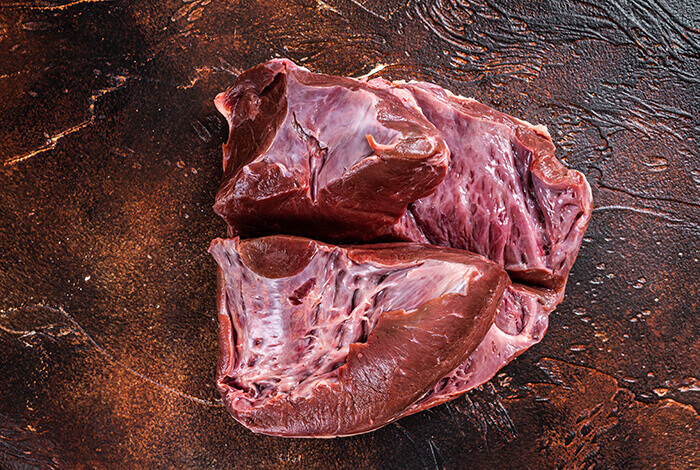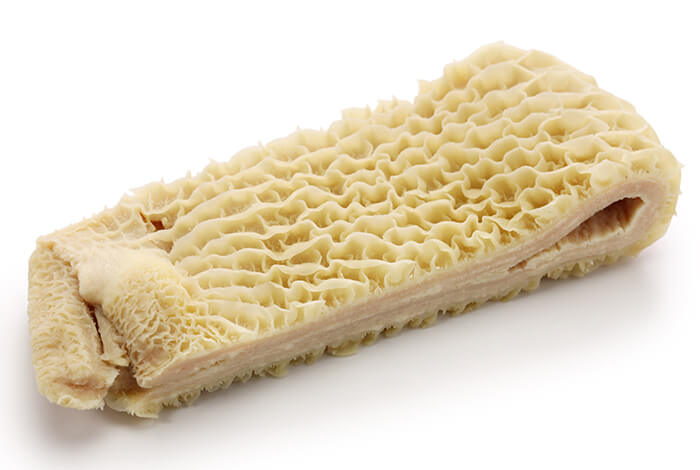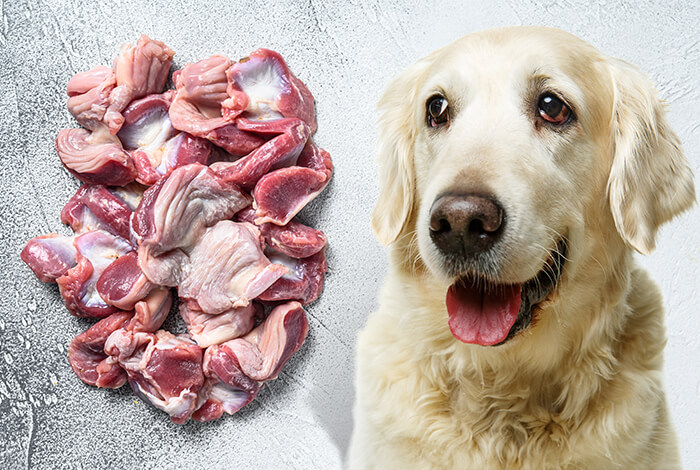Organ meats for dogs may sound unappealing, but the offals’ amazing nutritional values cannot be ignored. Each organ meat variety contains impressive levels of proteins, amino acids, antioxidants, vitamins, and minerals. These are considered superfoods for dogs and an excellent addition to their regular diet.
On top of all the health reasons, organ meats are a sustainable and healthy way to feed our pets a meat-based diet while reducing waste.
What Are Organ Meats for Dogs?
 Organ meats are the internal organs and entrails of larger animals, often called “by-products,” which exclude hair, horns, teeth, or intestinal contents. They are commonly sourced from cows, pigs, cattle, and sheep but may also come from other animals such as chickens, ducks, and turkeys.
Organ meats are the internal organs and entrails of larger animals, often called “by-products,” which exclude hair, horns, teeth, or intestinal contents. They are commonly sourced from cows, pigs, cattle, and sheep but may also come from other animals such as chickens, ducks, and turkeys.
Is Organ Meat Good for Dogs?
Yes, organ meat is good for dogs because it is nutrient-dense. Organ meat contains ample amounts of essential vitamins and minerals that canines need, such as vitamin A, B-vitamins, iron, and phosphorus. And even better, dogs love the taste of it.
Choosing the Best Organ Meats for Dogs
Not all organ meats are highly beneficial to the overall health of canines. To answer the question, “What organ meats are good for dogs?” we have enumerated the organ meats that offer high levels of nutritional value and health benefits to dogs:
Liver
 Liver is one of the best organ meats for dogs. It is a great source of soluble vitamin A, supporting good digestion and a healthy reproductive system.
Liver is one of the best organ meats for dogs. It is a great source of soluble vitamin A, supporting good digestion and a healthy reproductive system.
Beef liver, in particular, is loaded with folate, which is essential for maintaining a well-functioning nervous system.
Liver is also rich in CoQ10. It is a powerful enzyme proven to be good for joint health and beneficial for large dogs and arthritic dogs. CoQ10 can also improve cardiac functions and strengthen the immune system.
Dogs with anemia can benefit from eating liver too. This organ meat for dogs is packed with iron, which is crucial for transporting oxygen and nutrients throughout the body.
Heart
 Heart is highly concentrated with an essential amino acid called taurine, which promotes good heart health. Low taurine levels in dogs is known as one of the causes of a serious heart disease known as canine dilated cardiomyopathy (DCM). It is advised if you suspect a lack of taurine could be the cause of your pet’s health condition, you should have him tested by your veterinarian.
Heart is highly concentrated with an essential amino acid called taurine, which promotes good heart health. Low taurine levels in dogs is known as one of the causes of a serious heart disease known as canine dilated cardiomyopathy (DCM). It is advised if you suspect a lack of taurine could be the cause of your pet’s health condition, you should have him tested by your veterinarian.
Chicken and beef hearts are loaded with essential fatty acids and B-vitamins that dogs need to keep their coat shiny and healthy. These organ meats for dogs offer an abundance of iron needed to normalize red blood cells.
Heart is also another great source of CoQ10, which acts as an antioxidant, preventing oxidative stress. It also inhibits mitochondrial damage, which is believed to be the underlying cause of cancer.
For this reason, heart is considered one of the best organ meats for dogs.
Kidneys
Kidney has a substantial level of vitamin A which is vital for eye health. A deficiency of this nutrient can cause night blindness and poor eyesight in dogs.
Trace amounts of selenium can be acquired from beef kidneys. This antioxidant wards off inflammation and ensures that all body cells are in good condition.
Green Tripe

Green tripe refers to the stomach lining of grazing animals. It can come from cows, lambs, pigs, and deer. The word “green” means the tripe is not bleached or processed.
Healthy gut bacteria known as Lactobacillus acidophilus are probiotics can be found in this organ meat for dogs. It keeps the digestive system in great shape, promotes proper nutrient absorption, and is important for a healthy microbiome and immune system.
Other nutrients dogs can get from tripe are selenium and B-vitamins. Selenium helps prevent various diseases, including seizures, skin problems, and arthritis. B-vitamins offer a wide range of health benefits, including healthy metabolism and gene activation.
Note that most nutrients in tripe disappear if this organ meat is canned or dried.
Reproductive Organs
Feeding reproductive organ meats such as ovaries, testes, and uterus to spayed or neutered dogs can benefit their health. These may provide natural replacement hormones that aid in managing spay incontinence.
Reproductive organ meats are believed to help prevent orthopedic disorders in large breed dogs too. The manifestation of this disease is linked to very early neutering.
Spleen
The amino acid tryptophan, a mood regulator in dogs, is present in the spleen. It is needed by their bodies to produce serotonin and melatonin. Both help reduce distress and calm down canines.
Spleen contains hefty amounts of zinc, which plays a significant role in ensuring normal thyroid functions. This mineral promotes a strong immune system too. Zinc deficiency in dogs makes them highly vulnerable to infections and diseases.
Brain
 Many holistic vets and neuropaths believe that organ meats can be used to remedy diseases afflicting corresponding organs. Thus, the brain may help prevent or manage canine neurological disorders. However, it is important to note that there is no scientific research to support these claims.
Many holistic vets and neuropaths believe that organ meats can be used to remedy diseases afflicting corresponding organs. Thus, the brain may help prevent or manage canine neurological disorders. However, it is important to note that there is no scientific research to support these claims.
But be warned that brains coming from cows and deer are prone to certain diseases such as mad cow disease and chronic wasting disease. For this reason, some dog owners opt to use pig brains instead.
Feeding dogs with brains is controversial due to the risk of BSE or mad cow disease. Even at high temperatures, prions are not killed, and it can have severe zoonotic implications, making it a cause for concern.
Pancreas
Pancreas has 10 times as much vitamin C as the raw liver. This is especially helpful in eliminating cell-damaging free radicals, improving vision, and preventing cognitive degeneration.
However, keep in mind that dogs can synthesize vitamin C independently. Thus, pancreas is more beneficial to pooches with vitamin C deficiency. Healthy dogs can have this organ meat as a supplement to their diet.
Pancreas is particularly lauded for the digestive enzymes it provides to dogs. These enzymes promote a healthier digestive system, especially for canines with sensitive stomachs or exocrine pancreatic insufficiency (EPI).
Thymus
Thymus has lower concentrations of nutrients compared to other organ meats for dogs. However, it does contain hormones that help enhance immune function.
The culinary term “sweetbreads” refers to the thymus or pancreas. However, in shops, sweetbreads can be a mixture of both types of organ meats. In some cases, brain is also included.
Gizzard
 Gizzard is an organ located in the digestive tract of birds. Gizzards are high in protein. Dogs can also get a healthy dose of iron, taurine, and zinc from consuming this organ meat.
Gizzard is an organ located in the digestive tract of birds. Gizzards are high in protein. Dogs can also get a healthy dose of iron, taurine, and zinc from consuming this organ meat.
Gizzards are also an excellent source of glucosamine. This is a natural sugar commonly used to treat dogs with joint problems and injuries. Diets of large breeds are often supplemented with glucosamine to ensure optimal joint health which is particularly important in older dogs.
Trachea
Trachea is another natural source of glucosamine for dogs. Pets with bone and joint issues can greatly benefit from eating this organ meat. Many pet owners use trachea to remedy tracheal ailments in canines.
Eyeballs
Eyeballs contain bioavailable retinol, which is commonly known as vitamin A. Feeding your dog this organ meat is good for his eyesight as it prevents vision degeneration.
Tongue
 Pooches can get a healthy dose of healthy fats from consuming tongues. These are essential for energy production, and keeping dogs active. Tongue provides vitamin B12, which plays a big role in maintaining dogs’ healthy brains, spines, and nervous systems.
Pooches can get a healthy dose of healthy fats from consuming tongues. These are essential for energy production, and keeping dogs active. Tongue provides vitamin B12, which plays a big role in maintaining dogs’ healthy brains, spines, and nervous systems.
Do All Commercial Dog Foods Contain Organ Meats?
Many pet companies include organ meats as ingredients in their dog foods. However, it is important to highlight that visceral and skeletal organ meats such as intestines or neck meat are commonly used by some pet food manufacturers.
Visceral and skeletal organ meats contain fewer nutrients compared to the organ meats for dogs listed above. With this in mind, don’t presume those dog foods labeled “made with organ meat” always contain organ meat rich in nutrients.
To pick a dog food with premium-quality organ meats, check the ingredients list. It should list down the names of prime organ meats individually.
Dog owners need to be aware that dry kibble typically undergoes high-heat processing. This depletes most of the nutritional value of organ meats. Preparing organ meats for your dog at home can offer higher nutrient levels compared to feeding dry kibble.
Muscle Meat vs. Offal Meat – Differences
Distinguishing muscle meat and offal meat is important. Although all of them are sources of nutrients, their nutritional values differ significantly.
Muscle meat is rich in protein but offers less nutrition to dogs. On the other hand, offal meat is a great source of vitamins and minerals needed by dogs. This is also another term for organ meats.
However, keep in mind that most raw feeders categorize some organ meats as muscle meat. These include:
- Gizzard
- Green tripe
- Heart
- Tongue
- Trachea
What are widely recognized as offal meats in raw diets are:
- Brain
- Kidney
- Liver
- Pancreas
- Spleen
- Testicles
When switching your dog to a home-cooked diet, keep in mind that feeding him protein-rich organ meats will not provide him with all the nutrients he needs. Thus, including offal meats in your dog’s diet is important to ensure he has sufficient nourishment.
How Much Organ Meat Should Dogs Eat in Raw Food Diet?
In raw feeding, most dog owners follow the rule that organ meats should consist of 10% of their pet’s diet. However, this is a common and big misconception. Dogs actually need around 25% of organ meat in their raw dog food diet.
If we look into a canine’s natural diet in the wild, the organ meats in most prey animals are about 25% by weight. When aiming for this percentage, make sure to feed your dog a wide variety of organs. This will ensure that he gets a balanced amount of nutrients.
Keep in mind that no single organ meat should comprise more than 10% of your dog’s diet. For instance, if you were only able to buy liver, avoid giving your dog more than 10% organ meat of his total meal.
Is too much organ meat bad for dogs
Yes, it is. If dogs eat too much organ meat, they might acquire excessive amounts of nutrients, which can harm their health.
For instance, excessive vitamin A levels can cause joint pains and dehydration. Too much vitamin D may prompt appetite loss and muscle atrophy in dogs.
Hence, it is important to maintain balance even if organ meats for dogs are packed with all sorts of nutrients. Make sure to adhere to the recommended feeding percentage when adding them to your dog’s meals to avoid undesirable health issues from cropping up.
How to Prepare Organ Meats for Dogs
When preparing the organ meats for your dog, avoid cooking them in high heat since the process will destroy most of their nutrients. However, boiling them in water for 5 minutes will still retain the majority of the nutritional content.
You can also blend organ meats in a food processor and divide them into ice trays. Let the ground organ meats freeze into cubes.
Then you can feed these to your dog once they are completely thawed. Store the rest of the ground organ meats in the fridge. These can last up to 3–4 months, depending on the quantity and how frequently you feed your pet.
Bear in mind to observe proper sanitation before and after handling raw meat. Clean and sanitize all areas that come into contact with raw meat, including your dog’s food bowl. Afterward, be sure to wash your hands thoroughly.
Sourcing Organ Meats for Dogs
There are many places you can source organ meats for your dog.
Grocery Stores
First and foremost, check your local grocery store. In most cases, it is stocked with the most common organ meats for dogs, such as the liver, kidneys, tongue, gizzard, brain, and heart.
If you want to keep the cost low, go to a discount grocery store. Parts of animals that are not in demand, including organ meats for dogs, are sold there often for an affordable price.
Ethnic Markets
Ethnic markets are a good source of organ meats for dogs that are rarely found in regular grocery stores. These kinds of shops are usually found in cultural districts. Asian markets or Asian grocery stores often offer a wide variety.
Butcher Shops
It is always a good idea to check your local butcher if they sell organ meats for dogs. In some cases, they do not display the organs as these can be repulsive to some people.
So make sure to ask the butcher instead of just looking at the display of meats. If the shop does not have organ meats, in most cases, the butcher will be able to order the organs for you.
Abattoir or Slaughterhouse
Your local abattoir or slaughterhouse is one of the best sources of fresh organ meats for your dog. Plus, these tend to be cheaply priced since they are not popular food sources for people.
You can find all sorts of organ meats for dogs there, from the most common to the rarest.
Local Farms
For pet owners living in rural areas, you will have a good chance of sourcing organ meats for dogs from local farms. You are likely to get organ meat for a low price or free when you make other purchases.
Organ Meat Dog Food Companies
Many pet food companies specialize in creating freeze-dried organ meat for dogs. These are commonly sold as single-ingredient treats or meal toppers. Both variations are handy in slowly introducing organ meats to your dog.
Our last takeaway is to choose organ meats for dogs from animals raised naturally or farmed organically. These are safer and contain more nutrients since they have better living conditions.
Animals grown on factory farms are more prone to diseases because they are heavily vaccinated and have poor diets. Thus, their organ meats collect toxins that can be harmful to your canine companion.
Conclusion
Opt for organ meats from animals that are naturally raised or farmed organically. These options are not only safer, but they also provide more nutrients due to better living conditions. On the other hand, animals raised on factory farms are more susceptible to diseases due to heavy vaccination and poor diets. This leads to toxins being stored in their organs, which can be harmful to your dog.

